“The more difficult the victory, the greater the happiness in winning.” — Pelé. This saying is very true in baseball, where every swing can make or break the game. To do well, I need to make sure my bat is in top shape. Knowing how to spot a damaged bat is key to playing better and staying safe.
Using a broken bat can hurt my game and even be dangerous. In this article, I’ll share important signs to check my bat for damage. I’ll also talk about the dangers of using a broken bat and why checking my gear often is important. For more tips on spotting bat damage, check out this resource and learn how to keep my bat in good condition.
Key Takeaways
- Recognizing signs of a damaged baseball bat can enhance performance.
- Inspecting for cracks and dents is vital in detecting a cracked baseball bat.
- Using a compromised bat can lead to decreased safety and performance.
- Conducting regular bat inspections can increase its lifespan.
- Understanding proper maintenance techniques is crucial for bat longevity.
Understanding the Importance of Bat Maintenance
Keeping your baseball bat in good shape is key to doing well on the field. A bat is like any other tool that needs regular care to work right. By sticking to a maintenance routine, my bat performs better and lasts longer.
Ignoring your bat can lead to hidden damage and lower performance. This makes it tough to get the results I want in games. Knowing how to spot damage early can keep my bat reliable.
Simple steps like cleaning after each game, storing it right, and checking for wear can help. These actions not only save money but also give me confidence when I play. By following these tips for extending your bat’s lifespan, I make sure my bat is always ready.
Common Baseball Bat Damage Signs
Knowing how to spot damage on a baseball bat is key to keeping it in top shape. It helps me stay ready for every game. Regular checks let me catch problems early, keeping my bat performing well.
Cracks and Fractures
Cracks and dents often appear in composite bats due to pressure and impact. A crack not only looks bad but can also hurt the bat’s performance. Seeing cracks or fractures means I need to check it closely.
Dents and Dings
Aluminum bats get dents and dings from regular play. These marks can lower the bat’s performance, making it less effective. I watch for these signs to fix them before the next game.
Scratches and Cosmetic Blemishes
Minor scratches and blemishes don’t affect how well the bat works. But, they show it’s been used a lot. I keep an eye on these signs to keep my bat looking good.

| Type of Damage | Description | Impact on Performance |
|---|---|---|
| Cracks | Visible breaks in the bat material, often in composite bats | Reduces structural integrity, risking failure during use |
| Dents | Small indentations typically found in aluminum bats | Can diminish the bat’s pop and responsiveness |
| Scratches | Minor surface marks from regular use | Generally cosmetic, but can indicate frequency of use |
For more tips on choosing the right baseball bat and caring for it, check out this resource.
Signs Of A Damaged Baseball Bat
Spotting a broken baseball bat early can really help my game. I look for signs that show my bat is damaged. Each bat type has its own signs of damage, so knowing how to spot these is key.
Identifying Cracked Composite Bats
For composite bats, I check for hairline fractures or big cracks. These can really affect how far and hard I hit the ball. Checking for cracks early helps fix the bat and makes it last longer. Choosing the right bat size and caring for it well also improves my game, as explained here.
Detecting Dents on Aluminum Bats
With aluminum bats, I feel for dents on the barrel. Running my hand over it shows me any indentations that could affect its performance. This check is crucial to keep the bat working right during games.
Checking for Warping
Lastly, I look for warping, a sign that my bat is getting old. Keeping it straight is key for good performance, and bends can change my swing. Regular checks help me spot these problems early, saving me from future trouble.
Visual Inspection Techniques
Checking my baseball bat’s condition is key. I start by looking for any signs of wear or damage on the surface. This helps me spot problems early.
Surface Checks for Damage
I check the barrel for cracks or dents that could affect its performance. Running my hands over the surface helps me feel for bumps or rough spots. This method is crucial for finding damage that’s not easy to see.
Gripping and Texture Analysis
Inspecting the grip’s texture is also important. A worn-out grip can cause the bat to slip, hurting my game. I look for fraying or smooth spots that mean the grip might need replacing. Knowing how to inspect my bat helps keep it ready for games.
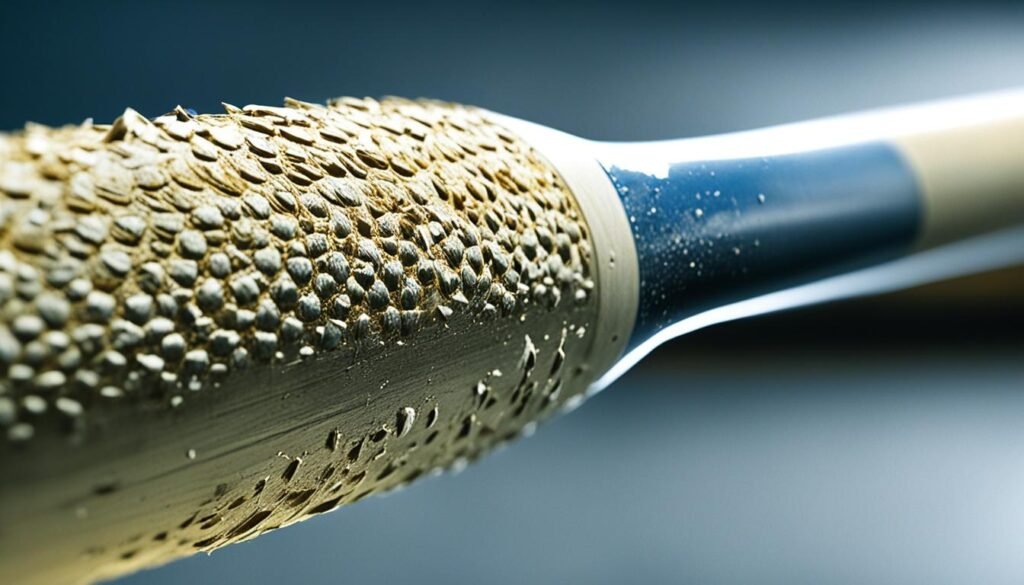
Sound Check: Listening for Changes
Checking the sound of a baseball bat is key for players who want to perform well. The sound when the bat hits the ball tells us a lot about its condition. Knowing the difference between normal sounds and dull thuds helps spot damage early.
Normal Bat Sounds vs. Dull Thuds
A healthy bat makes a clear, high-pitched sound when it hits the ball. This sound means the materials are good and working right. But, a dull thud means there might be cracks or damage inside. Checking these sounds during practice keeps me updated on my bat’s state.
Evaluating Resonance
Also, pay attention to the bat’s resonance after hitting the ball. A good bat makes a ringing sound that carries far. If this sound fades or gets quieter, it’s a sign of trouble. Doing a sound check for baseball bat performance can catch problems that just looking doesn’t show. This helps in finding damage before it affects the game.
Performance Testing and Observations
Testing my bat’s performance is key to knowing how well it works. I keep an eye on my batting stats and look for any signs that it’s not doing as well as before. Tracking my batting average and home runs helps me spot any issues with my gear. This way, I can see if my bat is giving me the results I want.
Tracking Batting Performance
When I track my batting performance, I look at important stats. These include:
- Batting average trends
- Home run and extra-base hit counts
- Strikeout and walk ratios
This info helps me see where I can get better and if my bat might be the problem. If I see my numbers going down, it’s time to check my bat.
Comparing Previous Seasons
Looking at my performance over the years helps me see trends. If I’m doing worse and my bat is older, it might be wearing out. Keeping track of my stats shows me if my gear is affecting my play.
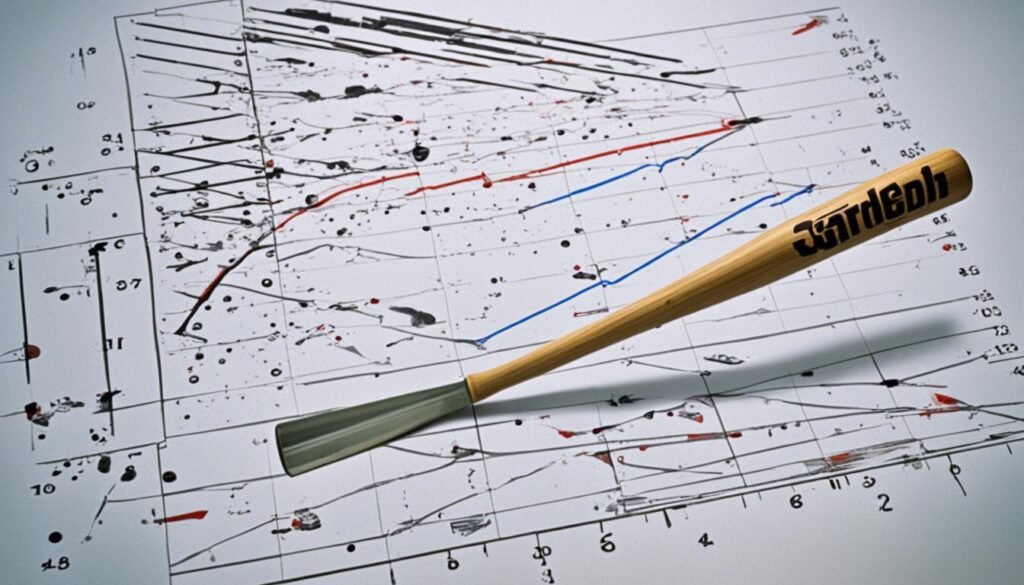
Feeling the Swing: The Importance of Comfort
The way my bat feels when I swing can really change my game. It’s key to check if the swing weight feels right. If it’s too heavy or off-balance, I know I need to look into it.
By paying attention to how the swing feels, I can get to know it better. This helps me perform better on the field.
Assessing Swing Weight Dynamics
Knowing about swing weight is key for doing well. I check how my bat feels on different swings. The weight affects my timing and control, which impacts my hits.
When I compare my current bat with others, I see if it’s right for me. This helps me decide if I need to make changes.
Identifying Changes in Feel
After hitting a lot, I’ve learned to spot changes in my bat’s feel. If it doesn’t feel right when I hit the ball, it might be damaged. I keep track of how long I’ve used my bat and any signs of trouble.
Signs of Wear and Tear on Bats
As a player, it’s key to watch for signs of wear and tear on my baseball bat. Spotting these signs helps keep my gear in top shape. Knowing what to look for stops me from thinking my skills are dropping when it’s really the bat’s fault.
Common Symptoms to Watch For
Damaged bat symptoms often show up in clear ways. Look out for cracks, splinters, and dents. Checking my bat often helps keep me safe and makes it last longer. I always check my bat for damage to catch problems early.
Signs of Decreased Pop
It’s also vital to watch for a decreased pop in my bat. If my hits don’t go as far, it could mean the bat is damaged. Knowing how to tell if your bat is damaged helps me decide if I need to fix or replace it. Checking how my bat performs is as important as checking its condition.
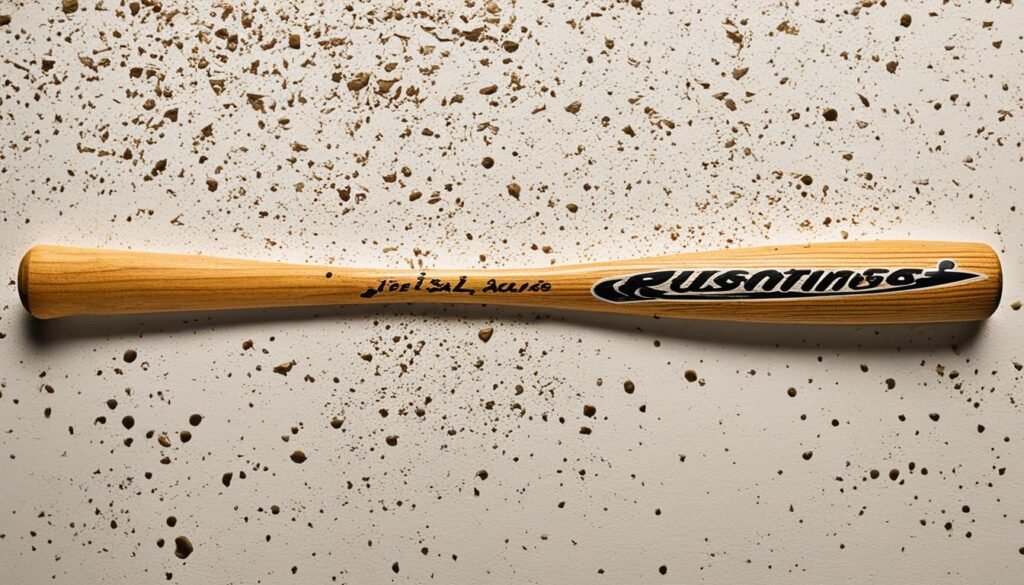
For more info on when to replace my bat, I look at resources like this guide. It highlights the need to keep my baseball gear in good shape.
The Risks of Continuing to Use a Damaged Bat
Using a damaged baseball bat can lead to many risks. It can make my swing less accurate and less powerful. This means I might not hit the ball as well as I used to.
There are also safety concerns with a damaged bat. If it cracks, it could break during the game. This could hurt me or others nearby. It could also cause an accident if it breaks at the wrong time.
It’s important to know the dangers of using a cracked bat. I should not risk my health for a little extra performance. Keeping the game safe and playing well is always my top priority.
Detecting Deterioration in Bat Materials
Knowing what baseball bats are made of is key for keeping them in good shape. It helps me spot wear and tear early. This means I can take steps to keep my gear lasting longer.
Differences Between Composite and Aluminum Bats
Composite bats are light and flexible. They show wear in their own way. I watch for:
- Splintering: Visible splinters mean serious damage.
- Fiber Breakdown: This shows up as fraying or color changes.
Aluminum bats have their own problems. Spotting issues in these bats includes:
- Dents: Dents can hurt how well the bat performs.
- Surface Scratches: Scratches might not be a big deal but can affect the look.
Recognizing Splintered and Warped Bats
Regular checks help me spot splintering or warping. Important signs are:
- Fluidity in Shape: A warped bat doesn’t swing right.
- Inconsistent Surface Texture: Uneven surfaces can mean big problems with the material.
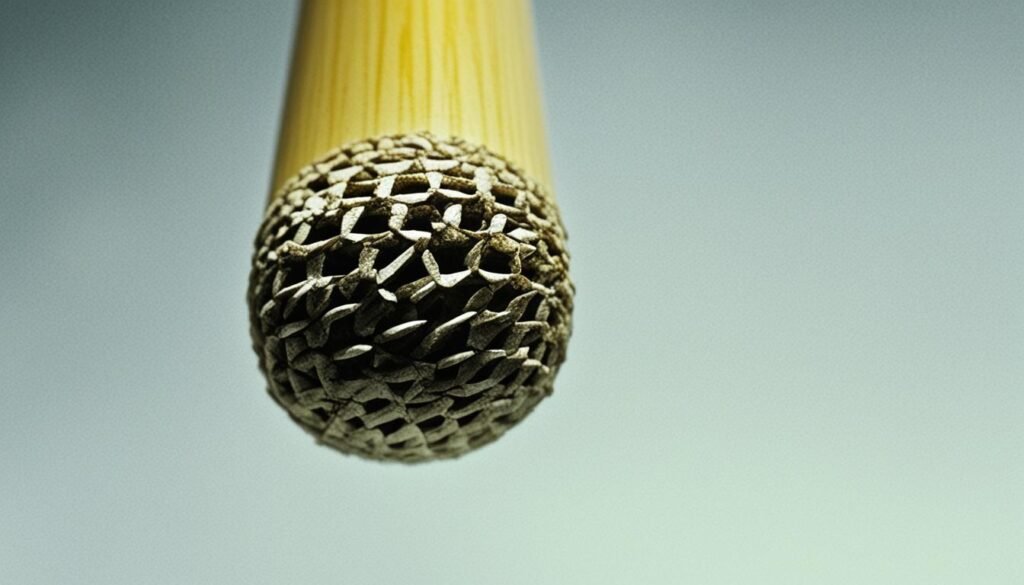
Conducting Regular Bat Inspections
It’s important to check my bat often to keep it in good shape. By checking my bat regularly, I can spot damage early. This helps me use my equipment well and avoid big problems later.
Setting a Routine for Bat Checks
I have a set time to check my bat. Doing this often helps me catch small issues before they get worse. After every game or practice, I make sure to inspect my bat.
Using Proper Lighting for Inspection
Good lighting is key for checking my bat. I make sure to inspect my bat in a well-lit area. This way, I can see any small cracks or scratches easily. With the right lighting, I can make sure my bat is always ready for the game.
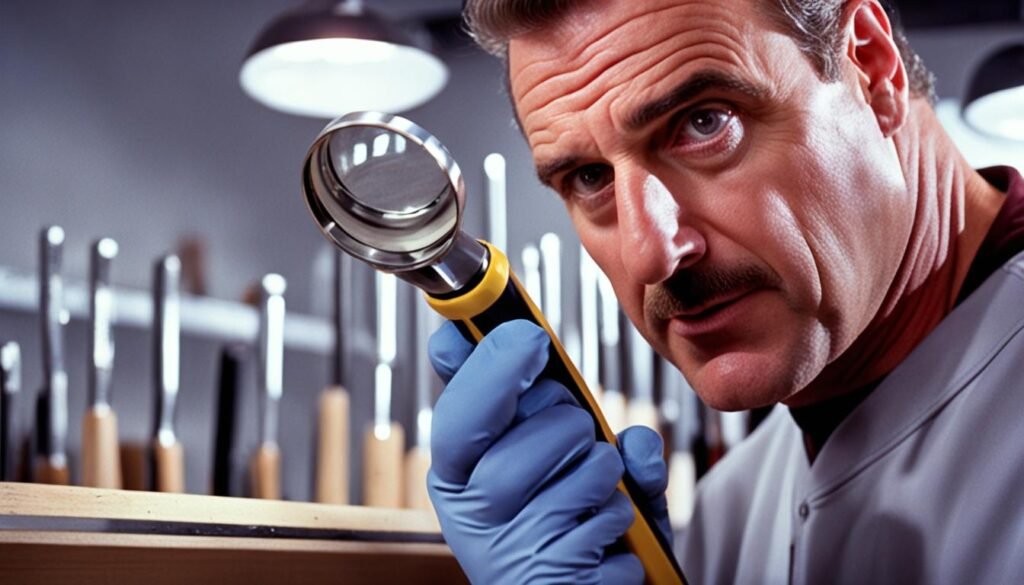
When to Retire Your Trusted Bat
Knowing when to retire a baseball bat is key for top performance. Each bat’s lifespan depends on its material and how often it’s used. Checking the lifespan of my bat helps me know when it’s time for a new one. Over time, signs show up that it’s time for a change due to wear and tear.
Understanding Lifespan and Usage Limits
It’s important to know how long my bat will last. Composite bats usually last up to 1,000 hits, while aluminum bats can go a bit longer, depending on quality and conditions. This knowledge helps me decide if using it more is hurting its performance.
Making the Decision to Replace
Checking my bat regularly for performance and wear signs keeps me ahead. If the bat feels different during swings or if I see cracks or less distance in hits, it’s time for a new one. Keeping track of my batting performance and checking my bat’s condition often helps me make the right choice.

| Bat Type | Average Lifespan | Signs of Wear |
|---|---|---|
| Composite | Up to 1,000 hits | Cracks, decreased performance |
| Aluminum | Up to 1,200 hits | Dents, warping, loss of pop |
| Wood | Varies widely | Splintering, cracks, breakage |
Tips for Extending Your Bat’s Lifespan
To keep my baseball bat in top shape all season, I use tips for extending bat lifespan. These tips boost performance and prevent damage. By storing my bat right and knowing what affects its durability, I can make it last longer.
Preventive Maintenance Practices
Regular preventive maintenance for bats is key. Here’s what I do:
- Store the bat in a cool, dry place to avoid extreme temperatures.
- Use a bat cover to protect it from scratches and dings during transport.
- Regularly check for any signs of damage before and after use.
These steps help keep my bat working well and save me from buying new ones.
Avoiding Common Mistakes
I’m careful to dodge common mistakes that can shorten my bat’s life. Here’s how:
- Using non-regulation balls that may cause distortion or cracks.
- Failing to clean the bat after games, leading to dirt buildup.
- Neglecting to follow the manufacturer’s guidelines for use.
Knowing these things is key to keeping my gear in good shape. For more tips on choosing the right bat, I check out guides like popular bat brands and their details.
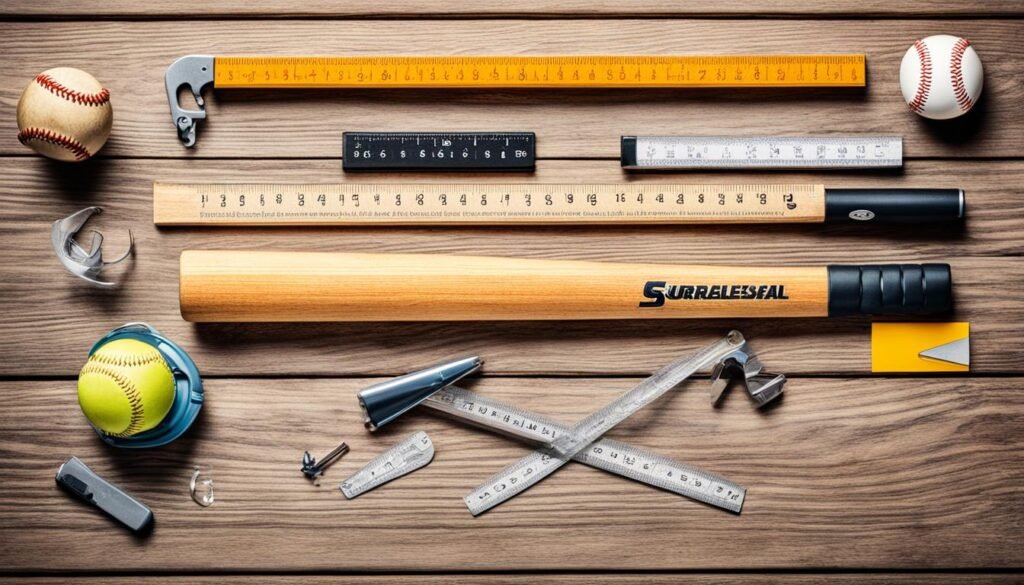
| Practice | Description | Benefits |
|---|---|---|
| Proper Storage | Keep the bat in a cool, dry location. | Prevents warping and cracking. |
| Regular Inspections | Check for dents, cracks, and overall condition. | Early detection of wear leads to informed decisions. |
| Cleaning Routine | Wipe down the bat after each use. | Removes dirt and debris, preserving finish. |
Recognizing Symptoms of a Damaged Bat
When I step onto the field, I keep an eye out for signs that my bat might be damaged. It’s key to know when my bat is not right to keep up my game and stay safe. If my hands vibrate more or I feel a sting when I hit the ball, it’s time to check my gear.
Signs of a Broken Bat During Play
During the game, there are clues that tell me if my bat is broken. These include:
- Decreased hit distance: If the ball doesn’t go as far, it might mean the bat is the issue.
- Peculiar sounds: Sounds like a loud thud instead of a crack can mean there’s a problem.
- Increased vibrations: Feeling more vibrations when I swing can mean the bat is wearing out.
- Visible physical damage: Seeing cracks, dents, or changes in weight can show the bat is damaged.
By watching for these signs and spotting a broken baseball bat, I can stop problems before they get worse.
Impact on Hitting Performance
How well I hit tells me a lot about my bat’s condition. If I’m not hitting as well, it’s a sign something’s wrong. I watch for:
| Indicator | Possible Issue |
|---|---|
| Drop in hit distance | Damaged bat material |
| Strange sound on contact | Cracked or broken bat |
| Increased vibrations | Structural integrity loss |
| Difficulty controlling bat | Weight distribution problems |
Knowing these signs helps me play better and keeps my performance up. A good bat is key to hitting well, so I always check its condition.
Cracked Baseball Bat: What To Do Next
Finding a cracked baseball bat can be upsetting, but there are steps to follow. First, check if your bat has a warranty that covers cracks. Many companies offer warranties for damages like cracks, so you might not have to pay for a new bat. Make sure you have your receipt from the purchase, as it’s key for your warranty claim.
Assessing Warranty Options
Look at the warranty info that came with your bat to understand the terms. Check if the warranty is still active. Some warranties last a short time, while others cover you longer. If you bought your bat from a trusted seller like JustBats, their customer service can help with your warranty claim and info on free shipping for replacements. Having all the details on cracked baseball bat options will make things easier.
Replacement Considerations
If my bat can’t be fixed, I should think about getting a new one. I’ll need to pick a bat that fits my playing style and performance needs. Getting advice and reading reviews can help me feel sure about my choice. It’s smart to look at different models before buying. For tips on picking the right gear, this guide has useful advice.
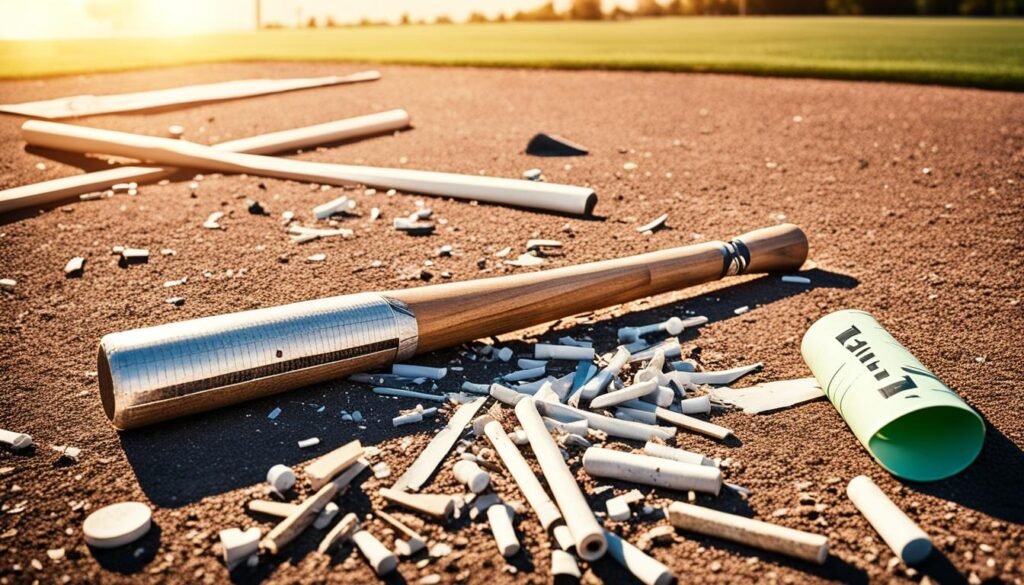
Where to Seek Professional Help
When I’m unsure about my baseball bat’s condition, getting professional help is key. Experts can guide me on what to do next. They spot issues I might not see, helping me understand my bat’s health and how long it will last.
Consulting Bat Experts
Talking to bat maintenance and repair pros is a smart move. They know a lot and can check my bat thoroughly. This way, I’ll know if my bat can be fixed or if I need a new one.
Finding Local Repair Shops
Looking for local bat repair shops is also a good idea. These places offer services for different bat types and brands. Their knowledge helps me keep my bat in top shape.
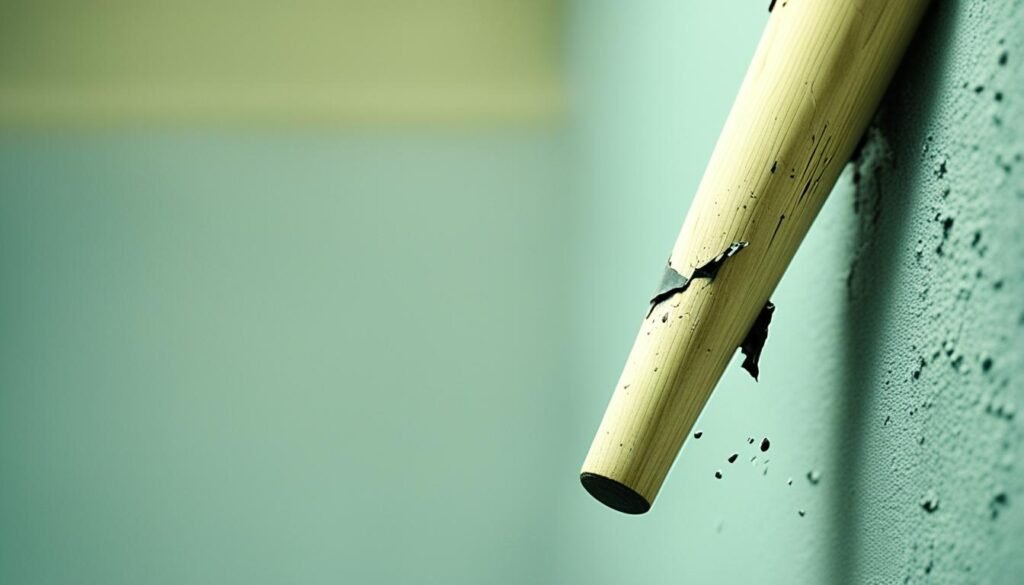
Conclusion
Knowing how to spot a damaged bat is key for my game and safety. I check my bat often for cracks, dents, and wear. This helps me decide if it’s still safe to use.
Keeping my bat in good shape is crucial. A simple check-up can help my bat last longer. Every time I inspect my bat, I’m taking care of my gear and improving my game.
Learning about damaged bats helps me take better care of my equipment. This knowledge makes me a better player. It ensures I play well and stay safe on the field.


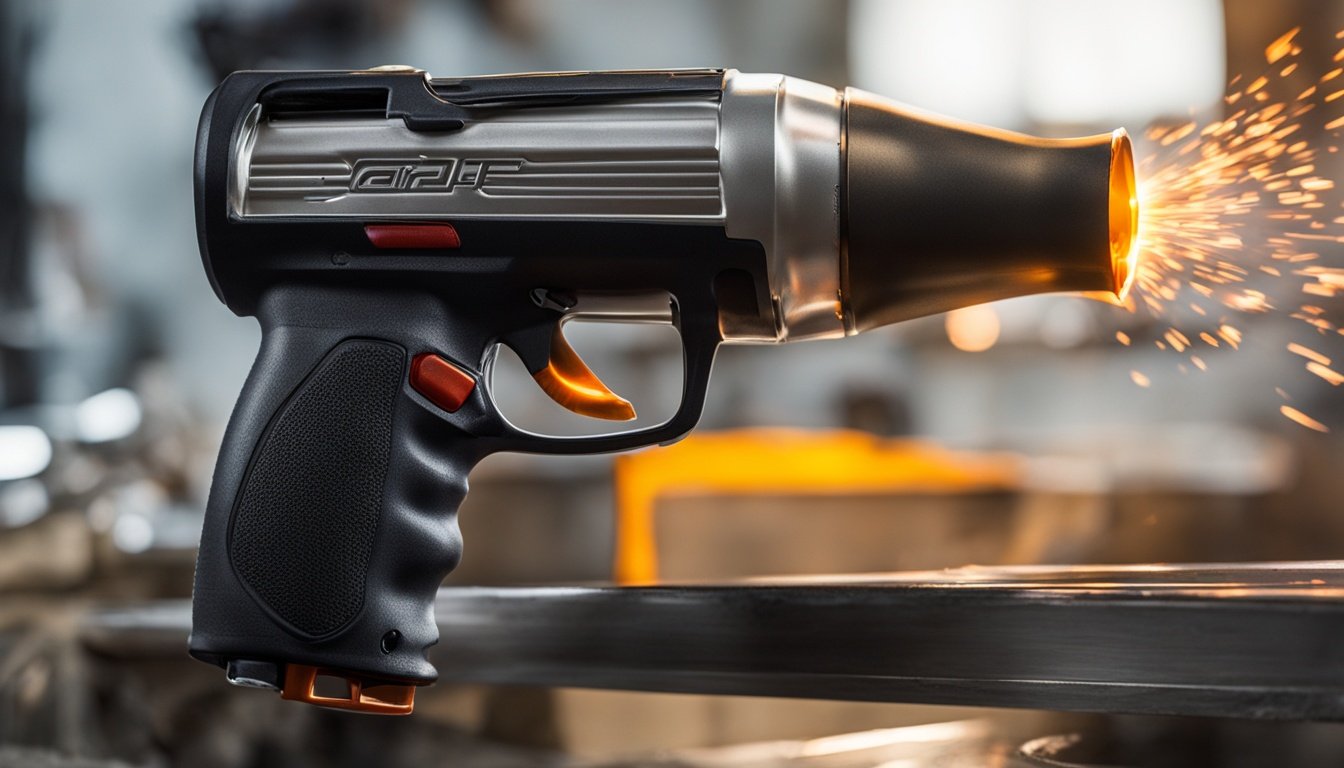
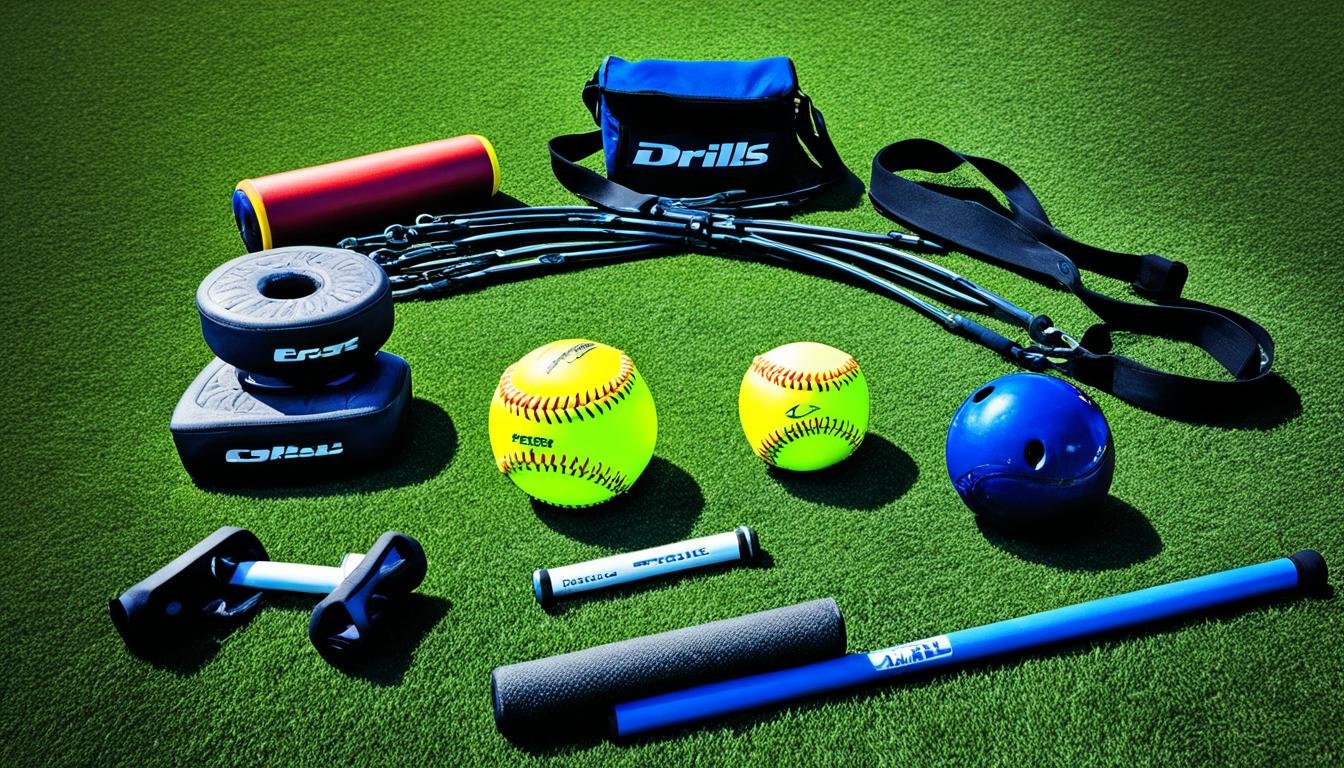


2 COMMENTS